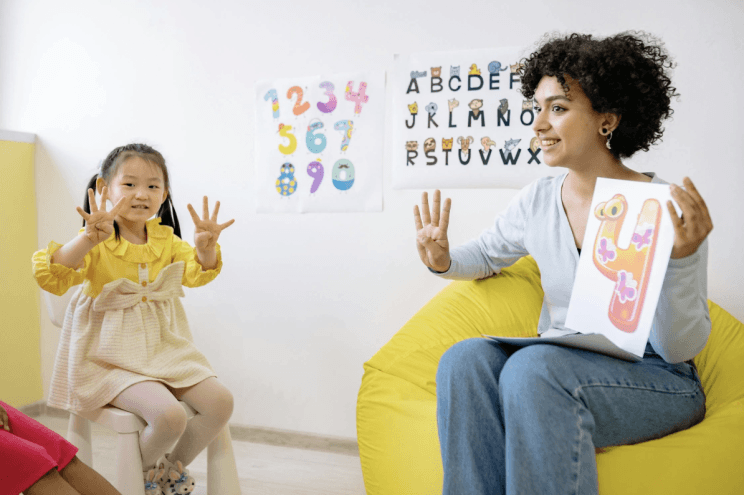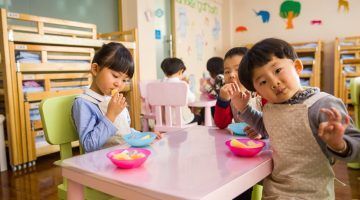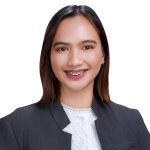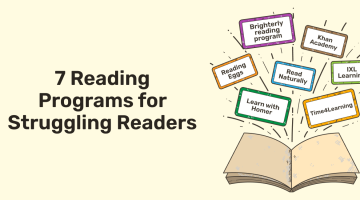Everything You Need to Know about Addition Facts
reviewed by Jo-ann Caballes
Updated on January 16, 2025
When children begin to study math, one of the first skills they learn is addition. This is why mastering the addition facts is a game-changer for their long-term success with mathematics. If you struggle to practice addition facts at home, I’ve got you covered with some of the best and fun ways to make learning addition facts a breeze.
Key Points
- Hiring a trusted Brighterly tutor is one of the best ways to help your child master addition facts through proven teaching techniques and gamified, interactive learning.
- Strategies such as using visual aids, practicing with flashcards, focusing on learning facts ‘families,’ incorporating games, and using repetition will help your child master addition facts quickly.
- Mastering mathematical concepts, such as math addition facts, enhances children’s self-esteem and equips them to tackle more advanced concepts.
What are the best ways to learn addition facts?
- With expert Brighterly math tutors
- Using Brighterly’s addition worksheets
- Through Brighterly’s interactive math tests
Kids begin to learn addition just after understanding how to count, but it doesn’t always mean it’s going to be easy. Questions like ‘What is the basic addition fact?’ and ‘How do I remember all of the addition facts?’ pop. This is why I prepared a couple of proven strategies to help children learn addition facts and make them more digestible:
Learn addition math facts with Brighterly Math tutors
Brighterly elementary math tutors use leading teaching techniques to help your kids learn addition math facts. They start with addition basics, specifically four basic operations: addition, subtraction, multiplication, and division. Using strategies like number bonds, visual aids like ten frames, and interactive games, tutors help your child ease into the world of basic addition facts that are fun and engaging.
For instance, children can practice adding numbers using colorful manipulatives or solve problems through addition fact games. By reinforcing speed and accuracy in gamified and interactive ways, Brighterly ensures your child builds a solid understanding of math addition facts and gains the confidence they need to tackle more intricate math problems.
To summarize, here’s why parents choose the addition math practice with Brighterly:
- The program is adaptive and customized to each student so children can focus on the addition facts they need help with.
- Gamified learning enables kids to build a solid understanding of addition facts with ease.
- Brighterly utilized leading teaching techniques to increase facts proficiency through structured and engaging approaches.

Note: Brighterly Math is an online 1-on-1 tutoring platform for elementary and middle school students that connects kids with top-tier math tutors. They blend game-based, interactive learning with a structured STEM-focused approach and a Common Core-aligned math curriculum. Additionally, Brighterly performs a rigorous background check to ensure every Brighterly tutor holds a Bachelor’s or Master’s degree in Math and has 5 to 15 years of experience in math tutoring.
Practice addition math facts with worksheets
Brighterly provides you with free printable math worksheets that contain hundreds of useful resources for learning and practice. If you look for something like ‘Everything you need to know about addition facts’ worksheets, Brighterly addition worksheets are available to you even if you don’t subscribe to the platform. Detailed explanations, engaging visuals, and step-by-step solutions are featured in the math worksheets to help your child understand the concepts and practice effectively. Also, the ‘Everything you need to know about addition facts’ worksheets are in PDF, so you can print them out when you’re ready to work.
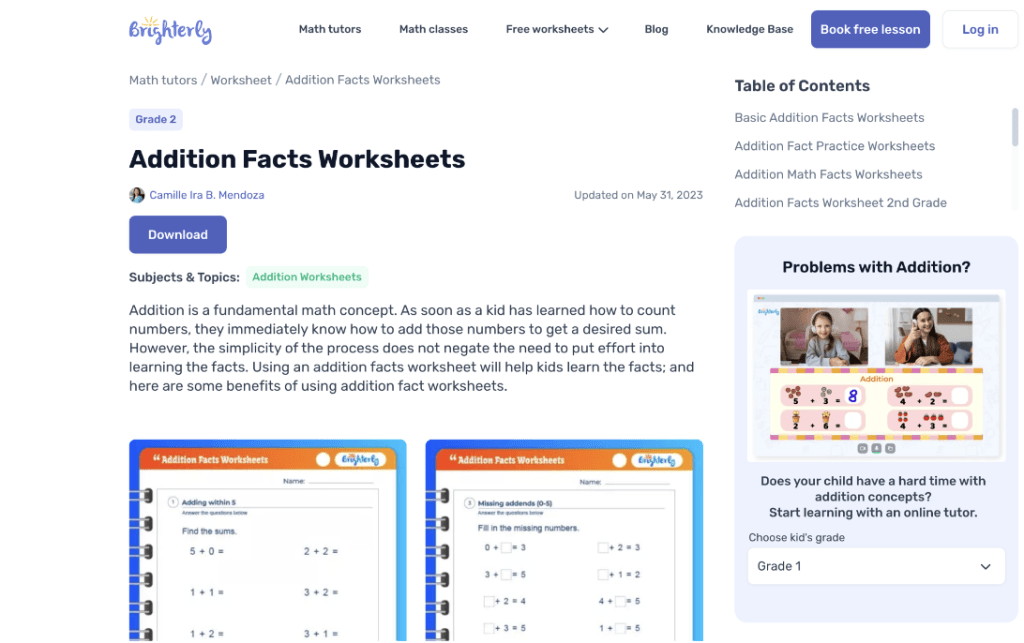
Furthermore, Brighterly Knowledge Base offers you articles on adding, number sense, measurement, money, times tables, word problems, and more, covering every math topic your child needs.
Get better at addition math facts with math tests
Addition is a fundamental math concept, and as soon as your child has learned how to count numbers, you have to move to addition. It may seem simple at first, but children have to put effort into learning the facts. Math tests are a great way for them to practice their numbers and addition in a way that is effective and fun. This is why the Brighterly Math program includes addition math facts practice tests, so your kid can practice them whenever they like.
Note: Testing your child’s math skills is essential for tracking progress and identifying areas of improvement.
Take a Free Diagnostic Online Math Test by Brighterly to find out your kid’s strengths and weaknesses in math and create a personalized learning plan.
How to memorize addition facts
- Use visual aids
- Practice with flashcards
- Group facts into families
- Incorporate games
- Use repetition and daily practice
You can memorize addition facts by: using visual aids, practicing with flashcards, focusing on learning facts ‘families,’ incorporating games, and using repetition will help your kid master addition facts in no time. Let’s go into more detail.
Note: Memorizing addition facts requires you to be creative and consistent and will significantly boost your child’s subtraction skills, making the overall process of solving math problems quick and easy.
Use visual aids to practice math facts addition
Most people need visualization to make abstract ideas stick, and that is especially true for children. If you’re trying to help them memorize addition facts, you absolutely have to use visual aids. You can use tools such as blocks, number lines, ten frames, counters, or even everyday objects like coins or buttons to help students better understand the process of adding items together and predict the outcomes of the calculations–addition facts.
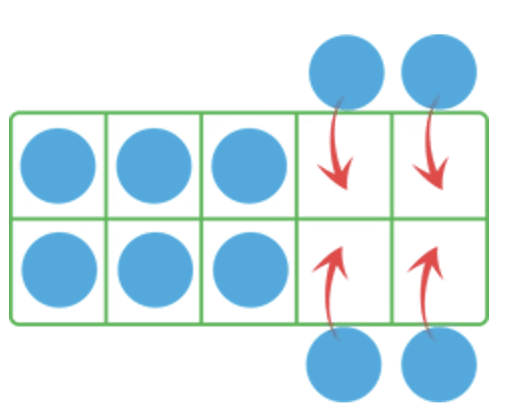
Addition fact practice with flashcards
Flashcards are a classic way to help children memorize addition facts, which is quite a practical task. You can turn it into a fun project and create it with your little one, or simply digital ones available online. Start with smaller sums and progress gradually to more complicated ones. To keep the practice exciting, you can time how many facts your kid can solve in a minute.

Group facts into families when you learn all about addition
Working with addition facts doesn’t always make sense to kids, so grouping facts into families can help alleviate confusion. Learning facts in systems makes addition more structured and intuitive. For example, if you know 3 + 4 = 7, then 4 + 3 = 7, and the related subtraction facts (7 – 3 = 4, 7 – 4 = 3) become easier. Groping numbers in systems and columns shows patterns and reduces the number of facts to memorize individually.

Incorporate games to learn addition facts fast
Games add excitement to the somewhat dull process of learning math facts. If your child feels stressed about memorizing facts table, incorporate board games, card games, and apps for addition fact online practice. For example, you can play ‘Addition Scavenger Hunt’ and hide numbered cards around the house and ask your child to find pairs that add up to a specific target number.

Use repetition and daily practice to memorize facts about addition
Building strong addition facts skills requires repetition and daily practice, and consistency is key. If you spend 5-10 minutes daily on worksheets, mental math drills, or puzzles, your child will gradually develop fluency and confidence in solving addition problems.
What are the important facts of addition?
Addition is one of four core operations and is represented by the symbol +. It starts with simple arithmetic, like 2+2=4, which are basic addition facts, to more complex objects in algebra. The important facts of addition include adding more than two numbers (for example, 2 + 4 + 6 = 12 / 2 + 4 + 6 = 12 / 2 + 4 + 6 = 12).
The addition is not just a simple arithmetic — it’s the foundation for more challenging math concepts like algebra. Here’s an example: today, your child will be doing simple additions like 2+2=4 today, and tomorrow, they will progress to something like 2x+3 = 7. Mastering mathematical concepts such as math addition facts with confidence enhances children’s self-esteem, leading them to feel equipped to advance to more advanced math concepts.
Now, let’s look into addition facts to 10 and how mastering them strengthens these skills further.
What are addition facts to 10?
Addition facts to 10 are the numbers that add up to 10 or less. For example, if you add numbers like 0, 1, 2, 3, 4, 5, 6, 7, 8, and 9 in different ways, you would get the result of 10 or less. Let’s look at the example: 2 + 6 = 8 is an addition fact to 10 because both numbers are less than 10, and their total is also under 10.
The primary goal of learning addition facts for grade 1 is to develop fluency in solving math problems. The missing piece to mastering this skill is regular practice and repetition. A child who knows addition facts can quickly recall that 6 + 4 = 10 without having to count on their fingers or use other strategies like writing addition facts. Children can also perform subtraction problems using these facts, such as 10 – 4 = 6.
The addition facts table is a great visual support for studying at home or in class.
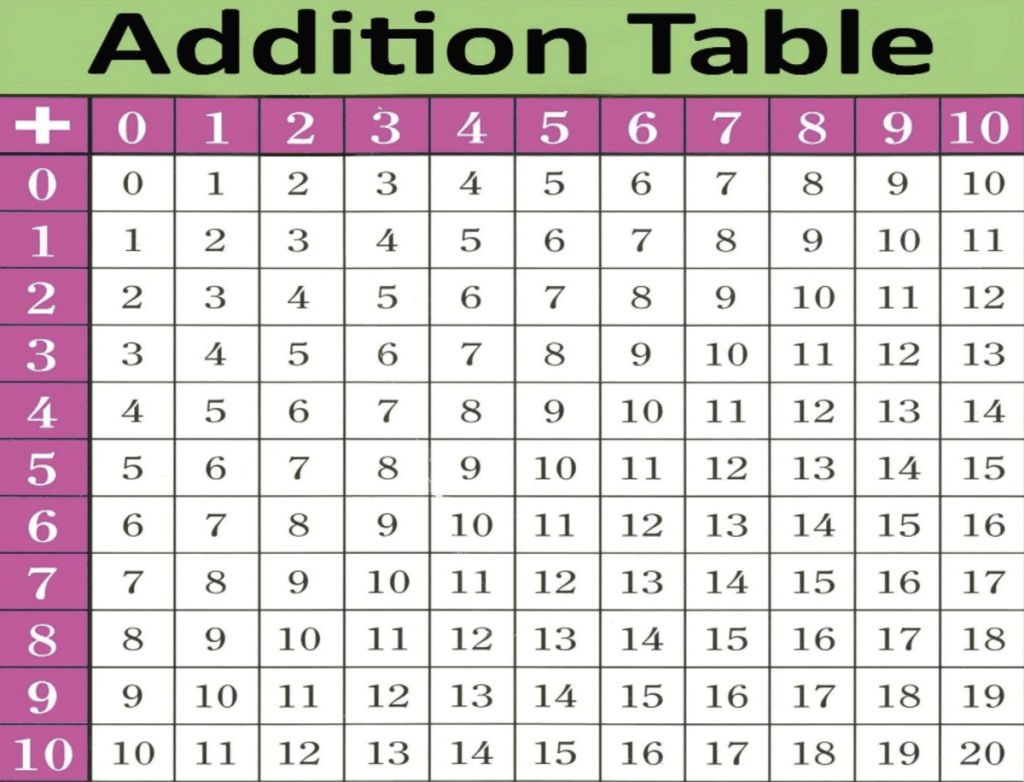
Next, let’s explore addition facts to 20.
What are addition facts to 20?
Addition facts to 20 are facts that use numbers from 0 to 20 and add up to 20 or less. For example, 10 + 10 is an addition fact to 20, as is 0 + 2. Knowing addition facts to 20 is vital for students in grades one and two because it helps them learn mental math techniques.
Addition doubles facts are additions of two similar digits of any existing number below 20. They serve as a base for adding numbers before learning the bigger ones. You can help to easily memorize them by using a mnemonic device, a simple way of remembering something new through a phrase or story.
Addition facts to 20 are essential for fluency and further skill development in math. If students memorize them, they won’t have to calculate problems each time they need to use one. Then, they can work on more complex math problems, such as multi-digit addition, without worrying about the individual sums within those equations.

Moreover, you can also use fun facts about addition games as an engaging way to help kids learn. Both teachers and parents can use them during the practice. Some interesting facts about addition games require you to download a free app and play them on your computer.
Now, it’s time to discover how addition facts help children subtract.
How do addition facts help you subtract
Addition facts help with subtraction by highlighting the inverse operation between the operations. For example, knowing that 5 + 3 = 8 will help you recognize that 8 – 5 = 3. This connection allows us to avoid errors, make the subtraction effortless, and improve problem-solving.

What are addition facts that can help you subtract? Each and every one of them! You can easily boost your subtraction skills by recalling addition facts. What you have to do is think about what two numbers you have to add up to get the number you’re starting with. For example, if you know 4 + 9 = 13, then 13 – 9 will give you 4. This is the easiest method to boost your subtraction mastery and make the math easier.
Conclusion
Now, having the right strategies to learn and practice addition facts is important. Strong addition facts skills can go a long way and boost your kid’s subtraction skills, algebra, and overall math confidence. After all, practice makes perfect, so try to make it consistent and engaging.
And if you’re ready for more effective math and and want to prepare your child for lifelong success — book your first free session with Brighterly Math Tutoring Platform.

